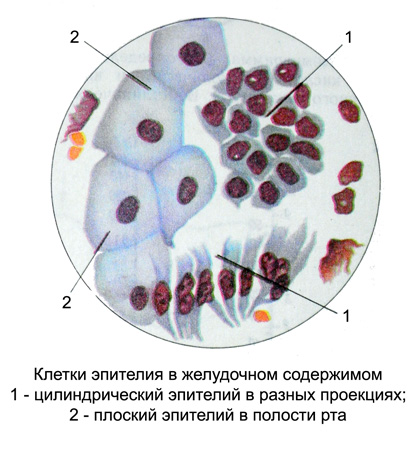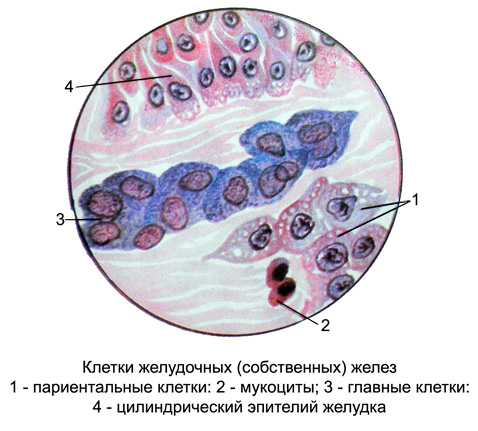Basic information about the structure of the stomach
Stomach - An important organ of the digestive system, in which the mixing and mass evacuation of food, the splitting of proteins to polypeptides.
In stomach distinguish:
- cardiac part - a place of transition of the esophagus the stomach;
- gastric fundus, Located high in the left upper quadrant;
- the body of the stomach, where secreted mainly pepsinogen and hydrochloric acid;
- pyloric part, which stands gastrin, and gatekeeper, through which the evacuation is carried out by reflex into the duodenum food masses, mixed with gastric juice.
Histologically, the wall of the stomach mucosa shows, muscular and serosa.

The mucous membrane of the stomach is made up of a single layer of columnar epithelium, own records and muscle and submucosa, defines a plurality of folds and dimples. The tops of the epithelial cells have a broader base and foamy (mucilaginized) view from the content of mucoid secretions, they produce.
In the interior of the lamina propria are stomach cancer. Depending on, in which part of the stomach, they are, distinguish cardiac, own cancer of the stomach and piloricheskle.
The most numerous own gastric glands. They play an important role in the process of digestion, constructed from main and parietal cells (glandulotsitov) and mucosal.

Primary cells dominate the structure of gastric: glands. Their cytoplasm is basophilic (It contains basophilic granules). These cells produce pepsinogen.
Parietal cells are intensely colored cytoplasm oxyphilic, containing the original secretory capillary network of the intracellular secretory Canadian). These cells produce hydrochloric acid.
Mucosal - Cells of small size with a relatively large core and thin rim intensely stained basophilic cytoplasm; secrete mucoid secretion.
In the neck of the gastric glands are Mucocytes with flattened, round, sometimes triangular shaped nucleus and basophilic cytoplasm. In these cells frequently mitotic figures. It is believed, Mucocytes neck that are involved in the regeneration of the cover and the glandular epithelium of the stomach.
In gastric glands are also stomach endocrinocytes (argentaffinotsity), which release histamine and serotonin, involved in the regulation of secretory activity of the gastric glands.
Cardiac Cancer It consists mainly of prismatic cells, mainly produce mucoid secretion. Main and parietal cells in these glands are rare.
Pyloric gland longer, branched, curved, It consists of mucosal, that secrete a secret base reaction, rich mucus. In the pyloric part of the stomach cells are found, containing granules of gastrin, that, presumed, They are the source of its formation.
Representation of the histological structure of the mucosa of the stomach normally underlies cytological diagnosis of diseases of the stomach, especially malignant tumors.
